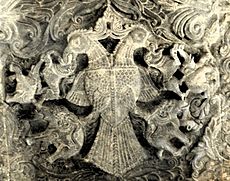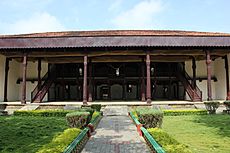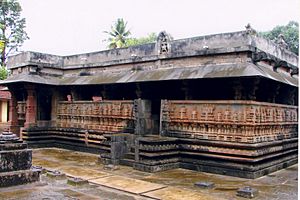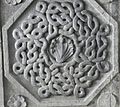Nayakas of Keladi facts for kids
Quick facts for kids
Keladi Nayaka Kingdom
Keḷadi Samsthāna
|
|||||||||||
|---|---|---|---|---|---|---|---|---|---|---|---|
| 1499–1763 | |||||||||||
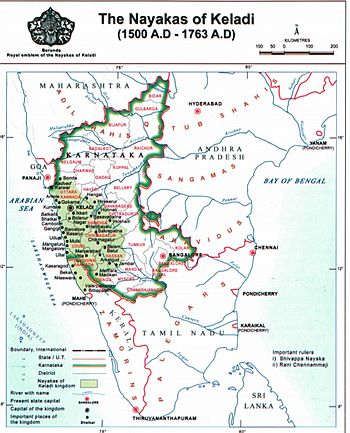
Greatest Extent Of Keladi Kingdom during the reign of Shivappa Nayaka.
|
|||||||||||
| Status | Kingdom (Subordinate to Vijayanagara Empire until 1565). Independent Kingdom till 1763 A.D. |
||||||||||
| Capital | Keladi, Ikkeri, Bidanur | ||||||||||
| Common languages | Kannada, Tulu, Malayalam | ||||||||||
| Religion | Hinduism | ||||||||||
| Government | Monarchy | ||||||||||
| Raja | |||||||||||
|
• 1499–1530
|
Chowdappa Nayaka | ||||||||||
|
• 1757–1763
|
Queen Veerammaji | ||||||||||
| Historical era | Post-medieval | ||||||||||
|
• Established
|
1499 | ||||||||||
|
• Disestablished
|
1763 | ||||||||||
|
|||||||||||
| Today part of | India | ||||||||||
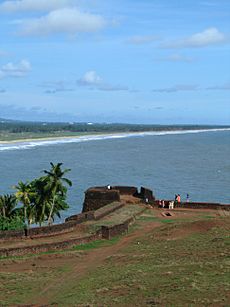
The Nayakas of Keladi (1499–1763) were an important ruling family in India. They were also known as the Nayakas of Bednore or Ikkeri Nayakas. Their kingdom was located in Keladi, in the Shimoga district of Karnataka, India.
They started as rulers under the powerful Vijayanagara Empire. But after the Vijayanagara Empire fell in 1565, the Keladi Nayakas became independent. They then ruled over large areas of Karnataka, including the hilly Malnad region and the coastal areas. They also controlled parts of northern Kerala and the plains along the Tungabhadra river. In 1763 AD, the Keladi kingdom was defeated by Hyder Ali and became part of the Kingdom of Mysore.
The Keladi Nayakas played a big role in Karnataka's history. This was a time when many parts of South India were in confusion after the Vijayanagara Empire ended. The Keladi rulers belonged to the Vokkaliga and Banajiga groups. They followed the Veerashaiva faith. The Haleri Kingdom in Coorg, which ruled from 1600 to 1834 AD, was started by a member of the Keladi family.
Contents
Important Rulers of Keladi
The Nayaka family had many strong leaders who helped their kingdom grow.
Chaudappa Nayaka (1499–1530)
Chaudappa Nayaka, originally named Chauda Gowda, was the first important chief. He came from a farming family near Keladi. He was a very capable leader who started ruling the area around Shimoga. He was a local ruler under the Vijayanagara Empire.
Sadashiva Nayaka (1530–1566)
Sadashiva Nayaka was a key leader in the Vijayanagara Empire. He was given the special title Kotekolahala by Emperor Aliya Rama Raya. This was because of his brave actions in the battle of Kalyani. During his rule, the coastal parts of Karnataka came under his control. He moved the capital from Keladi to Ikkeri, which was about 20 km away.
Hiriya Venkatappa Nayaka (1586–1629)
Many experts believe Hiriya Venkatappa Nayaka was the most skilled ruler of the Keladi family. He completely broke free from the control of the Vijayanagara rulers. An Italian traveler named Pietro Della Valle visited his kingdom in 1623. He described Venkatappa Nayaka as a good soldier and a smart ruler.
During his time, the kingdom grew very large. It included coastal areas, hilly regions, and parts to the east of the Western Ghats. He also defeated the Adilshahis of Bijapur. Even though he was a Veerashaiva, he built many temples for followers of Vaishnavism and Jains. He also built a mosque for Muslims. He even defeated the Portuguese in battles in 1618 and 1619.
Shivappa Nayaka (1645–1660)
Shivappa Nayaka is widely seen as the greatest and most capable of all the Keladi rulers. He was the uncle of the previous ruler, Virabhadra Nayaka. Shivappa took over the throne from his nephew. He was not just a good ruler, but he also supported literature and arts.
His successful battles against the Bijapur sultans, the Mysore kings, the Portuguese, and other nearby rulers helped the kingdom reach its largest size. It covered large parts of present-day Karnataka. He cared a lot about farming and created new ways to collect taxes. British officials later praised his tax system. A statue of him and his palace, which holds many old items, show how much people still respect him today. He also ended the Portuguese power in the Kanara region by capturing all their forts along the coast.
Keladi Chennamma (1672–1697)
Keladi Chennamma was a very strong female ruler. Some historians say she worked with the Maratha leader Shivaji and later his son Sambhaji. She did this to defeat others who wanted the throne. She famously gave shelter to Chhatrapathi Rajaram when he was running from the Mughal army. People in the area still tell stories about Queen Chennamma's bravery.
Queen Virammaji (1757–1763)
Queen Virammaji was the last ruler of Keladi. She was defeated by Hyder Ali, who then joined the Keladi kingdom with the Kingdom of Mysore. The queen and her son were captured by Hyder Ali. They were held in the fort of Madugiri. However, they were rescued in 1767 by Madhavrao I of the Maratha Empire. He defeated Hyder Ali in the battle of Madugiri. After their rescue, they were sent to Pune, the capital of the Maratha Empire, for safety.
Decline of the Kingdom
For over two hundred years, the Keladi kingdom controlled the coastal and hilly regions of Karnataka. They had a rich history of trading with the English, Portuguese, and Dutch. However, after the great Vijayanagara Empire fell, there was a lot of trouble. Constant wars against local chiefs, the Kingdom of Mysore, and attacks from the Marathas slowly used up all the kingdom's money. This eventually led to the end of the Keladi kingdom.
Literature and Arts
The Keladi rulers also supported writers and artists.
Kannada Literature
- Keladinripavijayam by Linganna
- Shivagita by Tirumalabhatta
Sanskrit Literature
- Shivatattvaratnakara by King Basavappa
- Tattva Kausthuba by Bhattoji Dikshita
- Ashvapandita by Manapriya.
Architecture and Temples
The Keladi Nayakas built beautiful temples in Ikkeri and Keladi. They used a mix of styles from the late Kadamba, Hoysala, Vijayanagar, and Dravida periods. They used granite for their buildings, just like the Vijayanagara architects did.
The Aghoreshwara temple in Ikkeri and the Rameshwara temple in Keladi are great examples of their art. You can see pillars with yali columns, which are like the ones in Hampi. These pillars show mythical horse-like animals with raised front legs and a rider. There are also lions, either standing or sitting.
In Keladi, you can find a roof sculpture of a Gandaberunda, the mythical two-headed bird of Karnataka. Inside the Rameshwara temple, a pillar carving shows Maratha Rajaram with Keladi Chennamma. This reminds us that Queen Chennamma protected Rajaram when he was fleeing from the Mughals.
Religious Tolerance
The Keladi Nayakas were Lingayats and supported their religion. They built many religious centers called mutts. They helped spread Lingayatism in the Malenadu and Coastal Karnataka regions. There were even sixty-four mutts in the Dakshina Kannada district alone.
However, the Keladi Nayakas were also very accepting of other religions and different groups within Hinduism. They invited Kazi Mahmoud, a grandson of the chief Kazi of the Adil Shahi kingdom, to live in Bhatkal. They even gave him land. Many Nawayath Muslims were given important jobs in the government. The families of these nobles still use "Ikkeri" as part of their names and live around Bhatkal. It is believed that the golden dome of the Bhatkal Jamia Masjid, also known as 'Chinnada Palli' (meaning 'Golden Mosque'), was a gift from the Keladi rulers.
Gallery
-
A parrot feeding its nestling in a frieze at Rameshwara Temple, Keladi, Shimoga District.
-
A large stone sculpture of Nandi the bull inside the Nandi mantapa.
See also
 In Spanish: Nayakas de Keladi para niños
In Spanish: Nayakas de Keladi para niños


